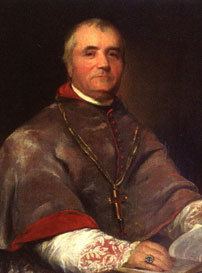See Diocese of New York Successor John Hughes Name John Dubois | Signature Term ended 20 December 1842 | |
 | ||
Ordination September 28, 1787by Antoine-Eleonore-Leon Le Clerc de Juigne Consecration October 29, 1826by Ambrose Marechal, S.S. Died December 20, 1842, New York City, New York, United States Organizations founded Mount St. Mary's University Similar People John Hughes, John O'Connor, Mary, Thomas Eckert, Pierre Toussaint | ||
Prof John DuBois of UCSB talks about stance triangles at Hypothes.is Reputation Workshop.
John Dubois, S.S. (French: Jean Dubois), served as the third bishop of the Roman Catholic Diocese of New York. He was the first Ordinary to reside in the diocese and was the first non-Irish born Bishop of New York
Contents
- Prof John DuBois of UCSB talks about stance triangles at Hypothesis Reputation Workshop
- Fr John Dubois Life with the Founders
- Early life
- Emigration to America
- Episcopate
- References
Fr. John Dubois: Life with the Founders
Early life
Dubois was born in Paris, France, on August 24, 1764. After theological studies at the Oratorian Seminary of Saint-Magloire in Paris, Dubois was ordained a priest on September 22, 1787, by Antoine-Eléonore-Léon Le Clerc de Juigné, the Archbishop of Paris. In Paris, Father Dubois served as an assistant to the curé of St. Sulpice as well as chaplain to a community of Sisters of Charity of St. Vincent de Paul.
The French Revolution placed many clergy in a dilemma, for the new regime required an oath renouncing loyalty to Rome and accepting the French government's authority over the church. Many Sulpicians fled to England, and in early 1791 Charles Nagot led a group which sailed to Baltimore, Maryland, where they opened a seminary, Saint Mary's, which is still in operation today. Dubois had attended the Collège Louis LeGrand with Maximilian Robespierre, who helped the disguised 27-year-old priest escape in June 1791 from what became the massacre of the non-oathtaking clergy, before his own fall from power and execution.
Emigration to America
Father Dubois landed at Norfolk, Virginia in August, 1791, bearing commendatory letters from the Marquis de Lafayette (whose wife was devout) to James Monroe, Patrick Henry, and members of other distinguished families including the Lees, Randolphs and Beverleys. All received him cordially, even ardent supporters of revolutionary principles like Mr. Monroe, who served as his host until Father Dubois rented a house in Richmond near a major bridge and opened a school to teach French, classics and arithmetic. Virginia had disestablished the Episcopal Church by statute in 1786, and that law also guaranteed freedom of religion, releasing the Commonwealth's small Catholic population from civil restrictions. Patrick Henry helped the priest learn English, and the two priests who alternated holding religious services in the capitol, the Episcopalian John Buchanan and the Presbyterian John Blair, became his friends. At the General Assembly's invitation, Rev. Dubois even once celebrated Mass in the courtroom of the new State House, but for two years mostly celebrated mass in rented rooms or at the homes of the town's few Catholic families.
In 1788, John Carroll, whom the Holy See had appointed superior of the American mission, was elected Bishop of Baltimore, with the permission of Pope Pius VI. In 1794, Bishop Carroll assigned Father Dubois to help in the pastoral care of the new nation's growing Catholic population nearer the Appalachian Mountains, with a base in Frederick, Maryland, which had become Maryland's second largest city as well as gateway to both Virginia's Shenandoah Valley and the trans-Appalachian Ohio Valley. After a farewell party in Richmond, the new missionary moved to Frederick, where he would serve a region stretching as far as the Mississippi River. The Jesuits, temporarily disestablished by the Holy See (only being restored as a religious order in the United States in 1805), had been serving this region's growing population for over a century. Their former residence in Frederick contained a chapel dedicated to St. Stanislaus Kostka. Meanwhile the town was booming. On May 15, 1800 Father Dubois consecrated the cornerstone of a new brick church on the North side of Second Street, naming the parish after St. John the Evangelist. For the next eleven years, Father Dubois served as pastor of St. John's Church, as well he traveled out into the frontier.
In 1806, Dubois joined the Sulpician Order and moved to nearby Emmitsburg, Maryland, where he founded Mount St. Mary's College and became its first president. The seminary trained missionaries, and was located on one of the major trans-Appalachian routes. During his presidency and with his support, a young New York widow, Elizabeth Bayley Seton, moved to Emmitsburg and founded the country's first Catholic girls' school as well as the first religious institute of teaching Sisters in the nation.
Episcopate
On May 23, 1826, the Vatican appointed Dubois bishop of the Catholic Diocese of New York. He was consecrated by the Archbishop of Baltimore, Ambrose Maréchal S.S., on October 29, 1826.
In 1837 Dubois traveled to Salina near Syracuse, to perform the marriage of Silas Titus and Eliza McCarthy, daughter of Thomas McCarthy (nominated first Mayor of Syracuse, New York) and sister of Dennis McCarthy. The marriage certificate became the first record of a Catholic service in Onondaga County. John McCloskey, later to become the first Archbishop of New York to be created cardinal, accompanied Dubois to Salina as a guide.
DuBois ordered that all church collections on Christmas Day be directed to the care of orphans. In 1838, he extended this to include the collection at Easter.
According biographer Richard Shaw, Dubois is buried under the sidewalk at the entrance to the Old St Patrick's Cathedral on Mott Street, which he requested, so that people could "walk on me in death, as they did while I was living". A plaque at the church's entrance memorializes the early bishop.
